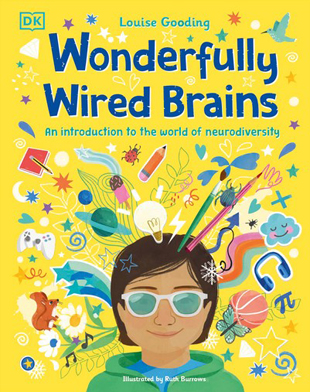Louise Gooding's Wonderfully Wired Brains has the potential to slice right through misunderstandings, taunting, and bullying among kids and create kinder and more respectful learning and play environments. There's no overestimating the value of a book with that power, because children who respect others tend to grow into compassionate adults.
Gooding greets readers by saying that her brain is wired with ADHD and also with her "likes, dislikes, fears, memories, thoughts, and feelings." After explaining a bit about how her brain works, she dives into sections:
- "Wonderfully working brains" – the science of brain function;
- "Wonderfully diverse brains" – descriptions of neurodiverse conditions (autism, ADHD, dyspraxia, dyslexia, processing disorders, anxiety, depression, OCD, or any other of sixteen ways of being "wonderfully unique” in one's learning style);
- "Wonderfully wired history” – histories of neurodiverse (and often misunderstood) people like Mozart, Florence Nightingale, and Harriet Tubman; and,
- "Wonderfully wired people” – current biographies of Olympians, social-media influencers, musicians, artists, and more who stand out in their fields in part because of how differently their brains work from what we think of as "typical."
Ruth Burrows' bright, engaging illustrations enhance Gooding's clear explanations, making an inviting book that readers ages seven to nine can use again and again as a resource. In the section about each of us being bult in our own way, for instance, we see colorful Lego-like blocks in a brain-like shape, with a variety of characteristics adorning the different blocks: such as "Friendly," "Athletic," "Enthusiastic," "Dyslexic," "Artistic," and more. We get a strong visual hit of the main point: "We can think of ourselves as diverse structures made from a variety of building blocks" rather than a single label or two.
No matter where they are on the spectrum from neurotypical to neurodiverse, children can learn much about themselves in these pages. They can also become more understanding of the gifts and needs of neurodiverse people around them.
Near the end, a section on brain care encourages children to drink enough water, stay active, take time for rest and recovery, and practice mindfulness. "Calming big feelings and emotions," Gooding writes, "can help you feel less anxious, and make space for happier, more peaceful thoughts." A two-page spread offers guidance on how to find information and help when readers have questions or concerns about how their brain is working. A glossary and an index round out this encouraging, informative book.
